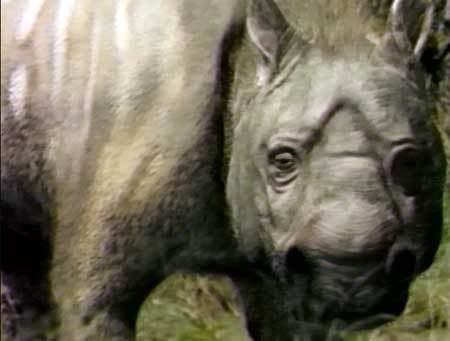Sniffer Wombat
Although the diprotodon genus is extinct elsewhere, a solitary species exists in Errinundera. It has been domesticated (sort of) and, with its extraordinary olfactory abilitiy, is extensively used to detect illegal products.
| Sniffer Wombat | ||||||||
|---|---|---|---|---|---|---|---|---|
| ||||||||
|
| ||||||||
History
Sniffer wombats are remnant diprotodons that scientists believe have existed in Errinundera for 1.5 million years or more. Whereas elsewhere in the world diprotodons died out when humans came into contact with them, in Errinundera the environmental beliefs of the Oo peoples that settled within their range meant that they were not hunted to extinction. The closely related hairy-nosed and common wombats, though much smaller, are still common in Errinundera and elsewhere.
Ecology and behaviour
Sometimes reaching a length of 3 metres and a height of 2 metres, sniffer wombats are formidable creatures when first encountered. Compared with other marsupials they are highly intelligent and are remarkable for their extraordinary sense of smell.
The nose is covered by a very tough cartilage. This horny surface and the amazing strength of its limbs and neck enable the wombat to crash through many obstacles.
Even though they are solitary in the wild, they can be tamed to some degree. This is a risky undertaking as they are perhaps the most single-minded creatures in existence. Should the creature set it's mind upon something then nothing can get in its way, be it rocks, trees, walls or people. For an example of the hazards posed by determined sniffer wombats read the news media article WOMBATS AMOK
</div>Sniffer wombat dig vast tunnels that they protect ferociously, especially females with a joey. Being marsupials they give birth to a single offspring that spends many months, even years in some cases, in the rear facing pouch. The male wombat remains solitary and plays no role in the nurturing of the offspring.
Although as a general rule the typical sniffer wombat eats roots and leaves, they have been known to be omnivorous, especially when their normal food sources are scarce.
Uses
Once hunted to a small degree by the Oo, this practice ceased when vegetarianism was adopted throughout Errinundera in the mid twentieth century. The Zu-vendi, for religious reasons, believed the meat was tainted and so never hunted it.
The keen sense of smell and the ability to bond with individual humans has resulted in sniffer wombats being used throughout Errinundera to detect banned substances such as meat, leather, guns and cars. They are most commonly encountered at border crossings. Even though there are no restrictions on movement across Errinundera's borders, the fearsome appearance and uncanny olfactory ability are effective deterrents against the importation of illegal items.
Sniffer wombat handlers
Because of the dangers involved in using sniffer wombats an entire industry of professional handlers has developed. Although skilful and well trained in their craft, the wombat is never fully domesticated and can behave in unexpected ways. Handlers are frequently killed by their charges but this seems in no way to deter the handlers' enthusiasm for the occupation. The typical handler feels a mixture of love and apprehension for their wombats.
Those wishing to enter the trade are taken on as apprentices to fully qualified handlers. It usually takes five to six years to master the trade.
Language
For obvious reasons the sniffer wombat language is the most extensively researched animal language in Errinundera. All handlers must be highly proficient in Diprotodontese in order to be awarded a full licence.
Leather
Although mostly herbivorous, sniffer wombats have a great love of leather. They will walk through brick walls if they think there is a meal of leather on the other side. It was this fetish that led Errinundrians to train them as sniffers. If trained from an early age they can learn some self-restraint, however this is never a certainty and wombats can go feral when they detect tanning chemicals. Fortunately leather is banned in Errinundera and so the problem is not common.


